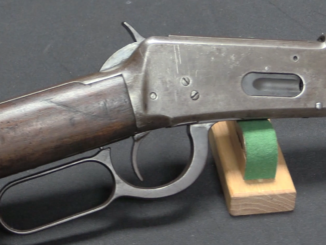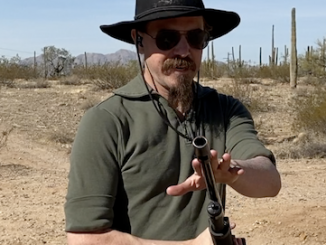Aircraft armament is an area of firearms study that is vastly under appreciated by most people, largely because it’s difficult to study aircraft guns without the aircraft themselves (and those take up a lot of storage space, among other things). William Wolf’s book on US WWII aircraft armament is actually much more than the title would suggest, basically covering all aircraft gun development from WW1 through 1945 (and later, in some areas). In addition, he discusses in dense detail the surrounding equipment that is a critical part of these guns: turrets, gunsights, ammunition, early radar systems, and more.
This is a book that will give you a tremendous crash course in all things aerial gunnery related. It is virtually all data, with little fluff at all (although there is some analysis, like the section on the debate between cannon (slow but very destructive) and machine guns (faster but less impactful). It’s not a book I would expect anyone to read cover to cover, but rather it is there for reference, or for reading sections individually for a bit of daily learning.
While the technical sections on things like electronic fire control systems will put some people to sleep, I think the balance between that and the firearms themselves is well done. The sections on iterative developmental models of all sorts of US aircraft guns are very interesting (and it includes a wonderfully snarky John Browning quote). The cover price is $70, and for the information it includes it would be a bargain at twice the price. If you have any interest in machine guns or firearms mechanics, it’s a great reference on a very much under-recognized aspect of the subject.
Available direct from the publisher (Schiffer) or on Amazon:




For an interesting take on figther armament of ww2: http://www.quarryhs.co.uk/WW2guneffect.htm
An excellent reference – spot on.
You have to wonder – why we need to buy a book 🙂
I’ve cited that site a number of times in on-line debates, generally to challenge those asserting the superiority of of the American M2 Browning argument over all other nations’. In fact, American armament was satisfactory for the uses it was being put to, and clearly better than the international standard of, say, 1940. By no means was it the ultimate, though.
Deployed armament can not be assessed without taking into account aeroplanes and how guns were integrated into them. USA prefer single-engined fighter planes machine gun installation in wings (like in P-47), which is stark contrast with Soviets which prefer fuselage-mounted guns (for example Yak-3).
Thanks for the mention of my site: perhaps I can add that on that site you can also find details of “Flying Guns World War II: Development of Aircraft Guns, Ammunition and Installations 1933-45” by Emmanuel Gustin and myself, which covers all nations not just the USA. There are companion volumes for WW1 and The Modern Era as well (but now getting hard to find).
“aircraft guns”
I would say these in relation to “land” guns, is like F1 racing cars to commuter cars. As aircraft guns should be lighter, fire faster (bigger Rate-of-Fire), have reliable feed system, which could be built placed into (generally cramped) spaces, like for example in wings, also for firing through propeller arc it should allow synchronization.
“debate between cannon (slow but very destructive) and machine guns (faster but less impactful)”
While certainly bigger projectile was more destructive, muzzle velocity depended on cartridge used. RAF used Hispano Mk.V giving muzzle velocity 840 m/s (HE shell) which is comparable with ·303 British Mark VIII (i.e. version for machine gun) at 770…884 m/s.
Very good comparison – commuter transportation to race vehicles. That fits perfectly.
@Daweo – The RAF was interested in aircraft cannon not for the “size” of the projectile, but rather in order to have a high explosive shell.
In the mid-1930s they evaluated various .50 calibre machine guns, but came to the conclusion that a .303 did enough damage and there wasn’t much advantage to a larger calibre gun unless it fired an explosive projectile. Unless a solid bullet hit something vital, even a .303 would simply go in one side of a typical aircraft of the day and out the other without doing much real damage. Making a slightly bigger hole didn’t really offer any advantage. On the other hand, being able to fire more projectiles more rapidly increased the probability of hitting something vital, so smaller guns held the advantage in that respect.
An explosive projectile however changed the game completely. Even one hit could result in a large number of fragments which could hit something vital. The RAF believed that 20mm was the smallest projectile that could fire a worthwhile explosive shell, so there wasn’t enough advantage in adopting an intermediate calibre gun such as .50 rather than jumping straight to 20mm when .303 wasn’t good enough.
The US evaluated the Hispano Suiza 20mm at the same time as the UK, and got their first sample guns from the same initial production run in France. However, the UK put a top priority to putting the gun into production right away while the US dragged their feet as they didn’t plan in getting involved in the war anyway. However, they did decide to adopt the gun.
As a result, the US procurement effort was very slow and bureaucratic. In addition, many problems were encountered when trying to put the gun into production, with the US Bureau of Ordnance both refusing to admit they had made any mistakes (some of the dimensions were incorrectly converted from metric to inches) while simultaneously trying to push their own not very good .90 calibre gun (based on the 1.1 inch ground based automatic anti-aircraft cannon). There were also bureaucratic turf wars due to anything larger than .60 calibre being considered “artillery”, so the gun got transferred from the machine gun department to the artillery department mid project, which didn’t help things either.
The end result was they were still struggling to get a working gun into service by the time the war ended. Post war efforts then ground to a halt due to a combination of the money taps being turned off, and also taking the time to evaluate German developments.
This looks like well researched book with lots of information.
When comes to my own interest in this subject it goes back to years of my youth. But later and even recently I was able to see and read about variety of armaments as pertains to the subject. It is still live subject to me albeit I cannot devote as much time to it as I wished.
Just couple of details on my recent experience. One worth of mention is .50cal M2 as modified for aircraft use which I have seen u close. My impression of it was that it only remotely resembles its ground parent form. Its weight and visible use of materials and finishes is different; it is technically attractive product. It would be interesting to know what was its manufacturing cost in comparison to basic land format.
Another such flash of recent experience is my last visit to Europe. On outskirts of Prague is Military aeronautical historical museum, with number of aircraft including sumptuous exhibits of German aerial armaments which some of were manufactured in Protectorate during WWII. I was impressed to see up close many arms I have read about previously. I recommend to everyone to visit this establishment; it is very much worth it.
“.50cal M2 as modified for aircraft use which I have seen u close”
But which variant exactly? In fact there existed many variants of that Browning high-caliber machine produced in different countries, U.S. made AN-M2 might be best known in context of WWII and GAU-21 https://fnamerica.com/products/weapon-systems/fn-m3m-gau-21/ in context of modern armaments, there existed as well:
Japanese knock-off namely Ho-103 (12,7×81 mm SR)
Finnish LKk/42 (12,7×99 mm NATO)
Swedish Akan m/39 (13,2×99 mm) [note that Akan in Swedish language means Automatic Cannon, so from Flygvapnet point-of-view this is not machine gun]
Belgian FN.39 (13,2×99 mm) made mainly for export purposes
All these gun have increased Rate-of-Fire in comparison to basic (ground) version, but Rate-of-Fire increase varied.
Those were either just before or war production units. The M3 is a possibility, but it may not stand your scrutiny, I realize it. But yes, I think that’s what it was.
Btw. I also read couple of novels at time when their printing received official green light (in mid sixties) relating to function of Czech and Slovak personnel in RAF during WWII. Good number of them flew on Wellington bombers, mostly night raids. One book well described proceedings from get up thru briefing, issuing personal equipment and instructions, boarding and take off thru actual conduct. Mission after mission, same grinding stuff. Needless to say, it was a horror for both parties, as in war is supposed to be.
The writer of one of those was acting as tail gunner; he commented on Vickers aerial guns (there were 4 of them in over/under configuration)
In his recollection, when they were let loose they sounded like “ripping canvas”. It has to be for their rate of fire putting out lots of lead in short span of time.
https://tailendcharlietedchurch.wordpress.com/tail-end-charlie-ted-church/rear-gunner-sentinel-of-the-skies/tail-gun-turret/
Oh, 4 guns were on Halifax. Wellington had just at 2 front and two in the back. https://www.youtube.com/watch?v=K5OMhR-Lm6s
Good (maybe) against Me110, but not against flak.
From the Mk III and onwards they had four guns in the rear turret. Better, but still not good against Flak:-)
Some place in past I have read or seen a video saying that U.S. Airforce gunners were, after return from a mission, taking weapons off their mounts with them and performing their own maintenance. Logically it would make sense since well working weapon was a lifeline during air combat. Does anyone has any info in that respect?
As both an airplane buff and gun buff, shut up and take my money.
You guys have touched upon stuff I’ve had opportunity to handle. Here we go: AN-M2 can refer to .30 cal, .50 cal and a 20mm aircraft weapon, due to the alpha-numeric logistic accounting system at the time. Post war replaced with FSN, then the current NSN system. The .30 AN-M2 is a jewel of a piece. HS 404 was adopted by the Brits and the US, the Brits got the chamber dimension right and were successful with theirs. The US went with M-1, M-2, M-3 and finally M24 (A, A1, A2, A3) never correcting it’s issues even with the Brit Ord guys willing to help. The Brits, French and US all used the revolver cannon (M39 in 20mm, DEFA and Aden in 30mm)that was a German development of an idea stolen from the Russians. The sights that Ian alluded to ie: K-13 used cable drives to take info from the host aircraft and feed into the mechanical/electronic computer to provide “lead” functions for the gunners. Most notably used with the E-11 and E-13 flex mounts. There are still NOS K-13’s floating around in their original boxes for sale so made. .50 cal M2-HB and M2-Ac share the same receiver box, the late war M3 is slightly different and has a much different backing plate. You’ll find all .50 variants still in use today, somewhere in the world. Aircrew usually took their guns out and handed them over to the armorers. Most fighters had two sets of guns in rotation. Side note: Looking for technical data on the late/post war .60 cal gun and it’s development.
“(…)Looking for technical data on the late/post war .60 cal gun(…)”
DATA FOR T17E5 FROM http://airwar.ru/weapon/guns/t17.html
Caliber: 15,2 mm
Principle: short-recoil
Gun body mass, including electro-mechanical reloading mechanism: 57,66 kg
Overall length: 2329,2 mm
Barrel length: 1524 mm
Rate-of-Fire: 700…750 rpm
Muzzle velocity: 1000…1070 m/s
Feed: belt
Bullet mass: 74,5…77,8 g
Cartridge: 15,2×114
Thanks Daweo, that looks like quite the resource.